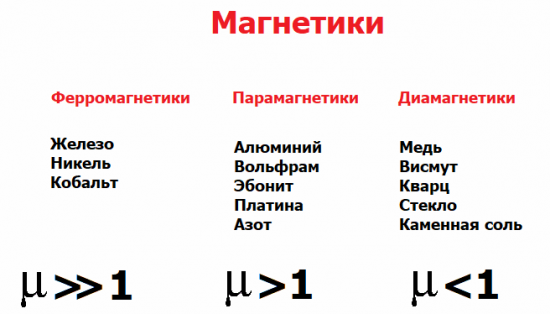Magnetic properties of matter for beginners
Although not every substance can be made permanent magnet, all substances placed in an external magnetic field become magnetized in one way or another. Some of the substances are more magnetized, and some are so weak that they cannot be seen without special devices.
When we say "substance is magnetized", we mean the fact that the substance itself has become a source of magnetic field due to the effect of an external magnetic field on it. That is, the parameters of the vector of magnetic induction B in the presence of this substance in a given space do not correspond to the vector of magnetic induction B0 in a vacuum, if the substance is absent.
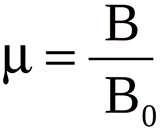
In connection with this phenomenon, such a concept as magnetic permeability of matter... This parameter of the substance shows how many times the magnitude of the magnetic induction vector B in a given substance is greater than in a vacuum at the same strength of the applied magnetic field H.
The nature of the reaction to an external magnetic field determines the magnetic properties of the substance, which depend on how the internal structure of these substances is arranged. Thus, three classes of substances with pronounced magnetic properties can be distinguished (these substances are called magnets): ferromagnets, paramagnets and diamagnets.
Ferromagnets and the Curie point
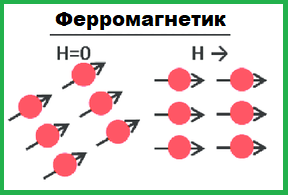
For ferromagnets, the magnetic permeability is much greater than unity. Ferromagnets include, for example, iron, nickel and cobalt. From them, as you can easily see, permanent magnets are most often made. It should be noted here that the magnetic permeability of ferromagnets depends on the magnetic induction of the external magnetic field.
The main characteristic of ferromagnets is that they are characterized by residual magnetism, that is, once magnetized, the ferromagnet remains so even after the source of the external magnetic field is turned off.
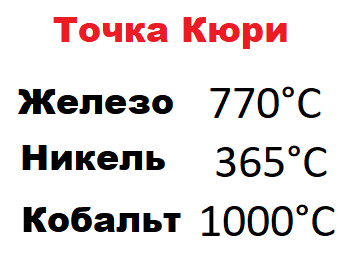 But if a magnetized ferromagnet is heated to a certain temperature, it will demagnetize again. This critical temperature is called the Curie point or Curie temperature—it is the temperature at which a substance loses its ferromagnetic properties. For iron, the Curie point is 770 ° C, for nickel 365 ° C, for cobalt 1000 ° C. If you take a permanent magnet and heat it to the Curie temperature, it ceases to be a magnet.
But if a magnetized ferromagnet is heated to a certain temperature, it will demagnetize again. This critical temperature is called the Curie point or Curie temperature—it is the temperature at which a substance loses its ferromagnetic properties. For iron, the Curie point is 770 ° C, for nickel 365 ° C, for cobalt 1000 ° C. If you take a permanent magnet and heat it to the Curie temperature, it ceases to be a magnet.
Paramagnets
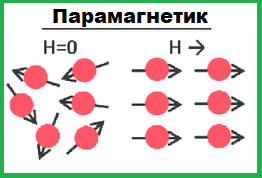
A number of substances that are held in an external magnetic field like iron, that is, are magnetized in the direction of the magnetizing field and are attracted to it, are called paramagnets.Their magnetic permeability is slightly more than unity, its order is 10-6... The magnetic permeability of paramagnets also depends on temperature and decreases with increasing.
In the absence of an external magnetic field, paramagnets have no residual magnetization, that is, they have no magnetic field of their own. Permanent magnets are not made from paramagnets. Paramagnets include, for example: aluminum, tungsten, ebonite, platinum, nitrogen.
Diamagnetism
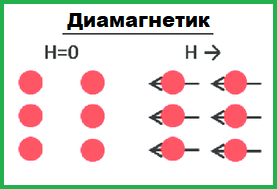
But among magnets there are also substances that are magnetized against an external magnetic field applied to them. They are called diamagnetic. The magnetic permeability of diamagnets is slightly less than unity, its order is 10-6.
The magnetic permeability of diamagnets practically does not depend on the induction of the magnetic field applied to them, nor on the temperature. When the diamagnet is removed from the magnetizing magnetic field, it is completely demagnetized and does not carry its own magnetic field.
Diamagnets include, for example: copper, bismuth, quartz, glass, rock salt. Ideal diamagnets are called superconductors, since the external magnetic field does not penetrate them at all. This means that the magnetic permeability of the superconductor can be considered to be zero.
See also: What is the difference between artificial and natural magnets?

